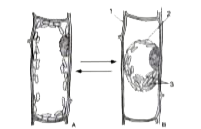Immerse a living cell in a hypotonic solution, and water will tend to
(a) move into the cell
(b) show no net movement
(c) move out of the cell
(d) move in by endocytosis
move into the cell
show no net movement
move out of the cell
move in by endocytosis
The correct Answer is:A
To solve the question regarding the movement of water when a living cell is immersed in a hypotonic solution, we can follow these steps:
1. Understand the Definition of Hypotonic Solution:
A hypotonic solution is one where the concentration of solutes outside the cell is lower than the concentration of solutes inside the cell. This means that the osmotic pressure outside the cell is lower.
2. Identify the Movement of Water:
Water moves from an area of lower solute concentration to an area of higher solute concentration. Since the inside of the cell has a higher concentration of solutes compared to the hypotonic solution outside, water will move into the cell.
3. Describe the Process of Endosmosis:
The movement of water into the cell is referred to as endosmosis. In this process, water molecules will enter the cell to balance the concentration of solutes inside and outside the cell.
4. Predict the Effect on the Cell:
As water enters the cell, the cell will swell due to the influx of water. If too much water enters, the cell may eventually burst, but initially, it will just become turgid (swollen).
5. Select the Correct Answer:
Based on the understanding that water moves into the cell in a hypotonic solution, the correct answer to the question is (a) move into the cell.
Final Answer:
(a) move into the cell
A hypotonic solution is one where the concentration of solutes outside the cell is lower than the concentration of solutes inside the cell. This means that the osmotic pressure outside the cell is lower.
Water moves from an area of lower solute concentration to an area of higher solute concentration. Since the inside of the cell has a higher concentration of solutes compared to the hypotonic solution outside, water will move into the cell.
The movement of water into the cell is referred to as endosmosis. In this process, water molecules will enter the cell to balance the concentration of solutes inside and outside the cell.
As water enters the cell, the cell will swell due to the influx of water. If too much water enters, the cell may eventually burst, but initially, it will just become turgid (swollen).
Based on the understanding that water moves into the cell in a hypotonic solution, the correct answer to the question is (a) move into the cell.
(a) move into the cell
Topper's Solved these Questions
- BOOK - ICSECHAPTER - TRANSPORT IN PLANTS EXERCISE - TEST YOUR PROGRESS (Fill in the blanks with appropriate words )32videos
TRANSPORT IN PLANTS
- BOOK - ICSECHAPTER - TRANSPORT IN PLANTS EXERCISE - TEST YOUR PROGRESS (State whether the following statements are true or false)16videos
TRANSPORT IN PLANTS
- BOOK - ICSECHAPTER - TRANSPORT IN PLANTS EXERCISE - REVIEW QUESTIONS (Questions based on diagrams or set-up)30videos
TRANSPORT IN PLANTS
- BOOK - ICSECHAPTER - THE LIVING WORLD EXERCISE - Ncert Exercises (Differentiate Between )4videos
THE LIVING WORLD
Similar Questions
Knowledge Check
- Question 1 - Select One
If cell A with OP = 5 and TP = 4 is surrounded by cells with OP = 3, and TP = 1, what will be the direction of water movement ?
(a) From other cells to cell A
(b) From cell A to other cells
(c) Water will not move
(d) None of the aboveAFrom other cells to cell ABFrom cell A to other cellsCWater will not moveDNone of the above
Property of the cancer cells to move to other parts of the body is called
View SolutionCorrect the statements.
(a) Cells shrink in hypotonic solutions and swell in hypertonic solutions.
(b) Imbibition is a special type of diffusion when water is absorbed by living cells.
(c) Most of the water flow in the roots occurs via the symplast.View SolutionHow do substances like carbon dioxide (CO2) and water (H2O) move in and out of the cell?
View SolutionIn anther, meiosis occur in
(a) Tapetal cells
(b) Endothecial cells
(c) Pollen mother cells
(d) Stomium cellsView SolutionIn the given figures 'A' shows a cell in the normal state and 'B' shows the same cell after leaving it in a certain solution for a few minutes :

Give the technical terms for the condition of the cell as reached in B and as it was in A.View SolutionConsider the following events involved in stomatal opening
1. Turgor pressure of guard cells increases
2. K+ ions move into guard cells
3. Formation of malic acid
4. Water moves into guard cells
What is the correct sequence of these events leading to opening of stomata ?View SolutionSubstances that have a hydrophilic moiety can move across the cell
View Solution

